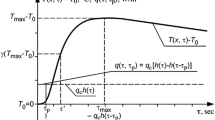Abstract
The line heat source method and the probe method for measurement of thermal conductivity are based on the same (or a very similar) theory. Both methods have been used to measure thermal conductivity of insulations, soils, biological materials, liquids, rocks, ceramics, and glass over a wide range of temperatures and other environmental conditions.
Access this chapter
Tax calculation will be finalised at checkout
Purchases are for personal use only
Preview
Unable to display preview. Download preview PDF.
Similar content being viewed by others
References
A.L.E.F. Schleiermacher, “Uber die Waermeleitung der Gase,” Ann. Phys. Chem. 34, 623 (1888).
B. Stalhane and S. Pyk, “New Method for Determining the Coefficients of Thermal Conductivity,” Tek Tidskr. 61, 389 (1931).
E.M.F. Van der Held and F.G. Van Drunen, “A Method of Measuring the Thermal Conductivity of Liquids,” Physics 15, 865 (1949).
F.C. Hooper and F.R. Lepper, “Transient Heat Flow Apparatus for the Determination of Thermal Conductivities,” ASHVE Trans. 56, 309 (1950).
H.S. Carslaw and J.C. Jaeger, Conduction of Heat in Solids, Oxford Univ. Press. London (1959).
J.H. Blackwell, “A Transient-Flow Method for Determination of Thermal Constants of Insulating Materials in Bulk,” J. Appl. Phys. 25, 137 (1954).
J.C. Jaeger, “Conduction of Heat in an Infinite Region Bounded Internally by a Circular Cylinder of a Perfect Conductor,” Aust. J. Phys. 9, 167 (1956).
D.A. de Vries, “A Non-Stationary Method for Determining Thermal Conductivity of Soil in Situ,” Soil Sci. 73, 83 (1952).
D.A. de Vries and A.J. Peck, “On the Cylindrical Probe Method of Measuring Thermal Conductivity with Special Reference to Soils,” Aust. J. Phys. 11, 255 (1958).
Arthur D. Little, Inc., “Studies of the Characteristics of Probable Lunar Surface Materials,” Final Report, prepared for Air Force Cambridge Research Laboratories under Contract AF 19(628)-421 (1962).
P. Prelovsek and B. Uran, “Generalised Hot Wire Method for Thermal Conductivity Measurements,” The Institute of Physics,0022–3735/84/080674, p. 674 (1984).
A.E. Wechsler and I.A. Black, “Design, Development and Fabrication of Thermal Measuring Systems,” prepared for National Aeronautics and Space Administration, George C. Marshall Space Flight Center, Huntsville, Alabama, Contract No. NAS 8–11708 (25 June 1964–25 March 1965).
G.B. Asher, E.D. Sloan, and M.S. Graboski, “A Computer-Controlled Transient Needle-Probe Thermal Conductivity Instrument for Liquids,” Int. J. Thermophys. 7(2), 285–294 (1986).
H.R. Thomas and J. Ewen, “A Reappraisal of Measurement Errors Rising From the Use of a Thermal Conductivity Probe,” J. Heat Transfer 108, 705 (1986).
A.E. Wechsler, “Development of Thermal Conductivity Probes for Soils and Insulations,” prepared for U.S. Army Cold Regions Research and Engineering Lab., Hanover, N.H., Contract No. DA 27–021-AMC-25(X) (Sept. 1965).
J.H. Blackwell, “The Axial-Flow Error in the Thermal-Conductivity Probe,” Can. J. Phys. 34, 412 (1956).
W.T. Kierkus, N. Mani, and J.E.S. Venart, “Radial-Axial Transient Heat Conduction in a Region Bounded Internally by a Circular Cylinder of Finite Length and Appreciable Heat Capacity,” Can. J. Phys. 51, 1182 (1973).
Pieter J. Bruijn, Izaak A. Haneghem, and Jacob Schenk, “An Improved Nonsteady-State Probe Method for Measurements in Granular Materials: Part I: Theory,” High Temp. High Pressures 15, 359–366 (1983).
H. Inaba, “Measurement of the Effective Thermal Conductivity of Agricultural Products,” Int. J. Thermophys. 7(4), 773–787 (1986).
P.G. Knibbe, “The End-Effect Error in the Determination of Thermal Conductivity Using a Hot-Wire Apparatus,” Int. J. Heat Mass Transfer 29(3), 463–473 (1986).
H.J. Goldsmid, K.E. Davies, and V. Papazian, “Probes for Measuring the Thermal Conductivity of Granular Materials,” J. Phys. E. 14, 1149–1152 (1981).
D. D’Eustachio and R.E. Schreiner, “A Study of a Transient Method for Measuring Thermal Conductivity,” ASHVE Trans. 58, 331 (1952).
V.E. Sweat and C.G. Haugh, “A Thermal Conductivity Probe for Small Food Samples,” Trans. ASAE, 56 (1974).
R. Von Herzen and A.E. Maxwell, “The Measurement of Thermal Conductivity of Deep Sea Sediments by a Needle Probe Method.” J. Geophys. Res. 64, 1557 (1959).
J.A. Koski and D.F. McVey, “Application of Parameter Estimation Techniques to Thermal Conductivity Probe Data Reduction,” Thermal Conductivity, 17, (17th International Thermal Conductivity Conference), pp. 587–600 (1983).
Author information
Authors and Affiliations
Editor information
Editors and Affiliations
Rights and permissions
Copyright information
© 1992 Springer Science+Business Media New York
About this chapter
Cite this chapter
Wechsler, A.E. (1992). The Probe Method for Measurement of Thermal Conductivity. In: Maglić, K.D., Cezairliyan, A., Peletsky, V.E. (eds) Compendium of Thermophysical Property Measurement Methods. Springer, Boston, MA. https://doi.org/10.1007/978-1-4615-3286-6_6
Download citation
DOI: https://doi.org/10.1007/978-1-4615-3286-6_6
Publisher Name: Springer, Boston, MA
Print ISBN: 978-1-4613-6445-0
Online ISBN: 978-1-4615-3286-6
eBook Packages: Springer Book Archive



